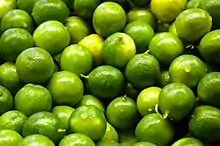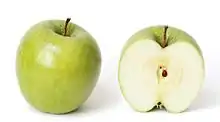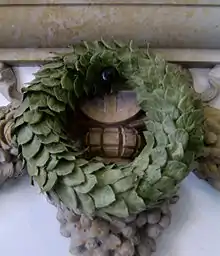Chartreuse (color)
Chartreuse (US: /ʃɑːrˈtruːz, -ˈtruːs/ (![]() listen), UK: /-ˈtrɜːz/,[1] French: [ʃaʁtʁøz])[2] is a color between yellow and green that was named because of its resemblance to the green color of one of the French liqueurs called green chartreuse, introduced in 1764. Similarly, chartreuse yellow is a yellow color mixed with a small amount of green that was named because of its resemblance to the color of one of the French liqueurs called yellow chartreuse, introduced in 1838.[3]
listen), UK: /-ˈtrɜːz/,[1] French: [ʃaʁtʁøz])[2] is a color between yellow and green that was named because of its resemblance to the green color of one of the French liqueurs called green chartreuse, introduced in 1764. Similarly, chartreuse yellow is a yellow color mixed with a small amount of green that was named because of its resemblance to the color of one of the French liqueurs called yellow chartreuse, introduced in 1838.[3]
| Chartreuse | |
|---|---|
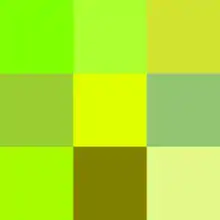 | |
| Hex triplet | #80FF00 |
| HSV (h, s, v) | (90°, 100%, 100%) |
| sRGBB (r, g, b) | (128, 255, 0) |
| Source | On the RGB color wheel, Chartreuse is defined as the colour halfway between yellow and green. The colour halfway between yellow and green on the RGB color wheel has a hex code of 80FF00. |
| ISCC–NBS descriptor | Vivid yellowish green |
| B: Normalized to [0–255] (byte) | |
Wrapping the spectrum into a color wheel
In a color proximity sense, a primary color has a color range of 120° (60° on each side of the color's hue) and any color has to be within that range to be considered a variation of that color. Secondary colors have a color range of 60° (30°), tertiary colors have a color range of 30° (15°), quaternary colors have a color range of 15° (7.5°), quinary colors have a color range of 7.5° (3.75°), and so on. Because chartreuse is located at a hue angle of 90°, it has a tertiary color range of 75° and 105°, and any color out of this range is more related to yellow or green than chartreuse.
If the visible spectrum is wrapped to form a color wheel, chartreuse (additive tertiary) appears midway between yellow and green:

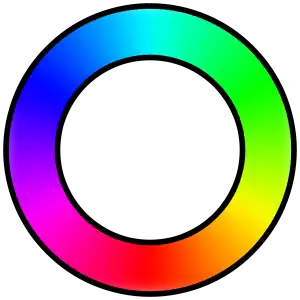
Etymology
The French word chartreuse means "charterhouse". The monasteries that the monks of the Carthusian order (who started producing Chartreuse liqueur in 1764) live in, of which the first one was established in 1082 by Saint Bruno, are called charter houses because they were chartered—and given generous material support—by the Duke of Burgundy known as Philip the Bold when he took over the area in 1378. Philip the Bold's elaborately decorated tomb was initially installed at a Carthusian charterhouse when he died in 1404.[4]
Chartreuse in nature
Algae
- Yellow-green algae, also called xanthophytes, are a class of algae in the Heterokontophyta division. Most live in freshwater, but some are found in marine and soil habitats. They vary from single-celled flagellates to simple colonial and filamentous forms. Unlike other heterokonts, the chloroplasts of yellow-green algae do not contain fucoxanthin, which is why they have a lighter color.
In popular culture
Traffic safety
- Chartreuse yellow is used on traffic safety vests to provide increased visibility for employees working near traffic. The chartreuse yellow background material, together with a retro-reflective satisfy the ANSI 107-2010 standard since 1999. Traffic Safety vest ANSI Standards were adopted as an OSHA (Occupational Safety Health Administration) requirement in 2008 (23 CFR part 634)
Electronics
- The early green LEDs are now sometimes called chartreuse to distinguish them from more modern, deeper-green LEDs.[5]
Film
- The 1960 Universal film Chartroose Caboose featured a "bright green" colored train car.[6]
Firefighting
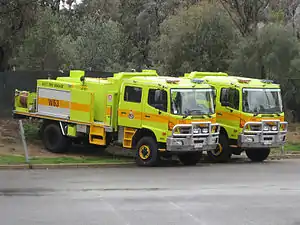
- Since about 1973, a sort of fluorescent chartreuse green has been adopted as the color of fire engines in parts of the United States and elsewhere. The use of chartreuse fire engines began when New York ophthalmologist Stephen Solomon produced research claiming that sparkling bright lime-green paint would boost the night time visibility of emergency vehicles compared to those painted the traditional fire engine red.[7][8] The reason for this is the Purkinje effect, i.e., the cones do not function as efficiently in dim light, so red objects appear to be black. In Australia and New Zealand this form of chartreuse yellow is also known as "ACT yellow" as this is the color of the fire engines in the Australian Capital Territory.
Literature
- In 2012, Chelsea Handler began to author a spoof on the popular book series Fifty Shades of Grey called 50 Shades of Chartreuse: This Time It's Personal.[9]
Music
- Jazz and jump blues saxophonist, singer, and bandleader Louis Jordan recorded the song "(You Dyed Your Hair) Chartreuse" in 1950. Composed by J. Leslie McFarland and Billy Moore, Jr., the song is about a girl who dyes her hair "chartreuse." Although she thinks that the color is "mighty cute," the speaker suggests that the change of color is a ridiculous act of rebellion.[10][11]
- A song on the Homestuck album The Felt is named Chartreuse Rewind, in reference to the color associated with the album, its subject matter, and by extension the traditional color of the felt on a billiards table.[12]
- American blues-rock band ZZ Top recorded a song called "Chartreuse" for their 2012 album La Futura.
- American indie-pop duo Capital Cities recorded a song called "Chartreuse" for their 2013 album In a Tidal Wave of Mystery.
- In C. W. McCall's song "Convoy", one of the vehicles participating in the convoy is a chartreuse VW Microbus, which is assigned by the singer/speaker as an escort to a truck hauling dynamite (due to the microbus carrying "eleven long-haired friends of Jesus" and the dynamite truck needing "all the help it can get").
- "Chartreuse" is a song on Ken Nordine's spoken word album Colors (1967).
Vexillology
- When Bharatpur State was a princely state, it was the only political entity ever to have a chartreuse yellow-colored flag.[13]
Video games
- The Chartreuse Hall is a hydroponics section in the game The Operative: No One Lives Forever, in the Low Earth Orbit mission.[14]
Chartreuse (computer)
Chartreuse (web color)
| Chartreuse (web color) | |
|---|---|
| Hex triplet | #80FF00 |
| HSV (h, s, v) | (90°, 100%, 100%) |
| sRGBB (r, g, b) | (128, 255, 0) |
| Source | X11 |
| ISCC–NBS descriptor | Vivid yellowish green |
| B: Normalized to [0–255] (byte) H: Normalized to [0–100] (hundred) | |

At right is displayed the web color chartreuse.
The term chartreuse is defined by the Oxford English Dictionary as: "A shade of colour; a pale apple-green". The dictionary gives a quotation in the British publication Western Daily Press (26 Dec. 1884) Vol. 7 No. 5 as being the earliest occurrence found in print of the term 'chartreuse' used as the name of a color. However the source does not define or describe the color referred to.[15]
In The Domestic Monthly (1885) is written, "The delicate, pale green, with a yellow tinge, entitled 'Chartreuse,' is a rival to the renewed apple green," and, "The new shade of Chartreuse green, from light to dark, is lovely in the large feather fans. ... Some of the corded silks have fancy stripes in a combination of colors such as ... mousse and Chartreuse, which is the stylish yellow green."[16]
In The Ladies' Home Journal of May 1889, is written, "Chantilly cloaks come shaped like the old-fashioned rotonde, with collar of narrow lace, and are worn over a lining of chartreuse green or jonquil yellow."[17]
In The Millinery Trade Review (1889) is written, "From Madame Catlin of Paris, a hat of velvet in moss-green of medium tone, or of strong Chartreuse-green."[18]
In The Mineral Industry (1898) is written, "The characteristic twin colors of a few doubly refractive gems will prove of interest ... tourmaline green (chartreuse green and bluish green).[19]
In Dry Goods Reporter (1905), it is noted under "Choosing an Easter Hat" — "Chartreuse greens are among the colors hardest of all to combine artistically, and yet with the new popular bluet are charming."[20]
In Pure Products (1910) is written, "The following colors can be bought in powder form ... chartreuse green".[21]
"Chartreuse Green" is also listed in Plochere Color System (1948).[22]
In a 1956 edition of Billboard, a jukebox is advertised as being available in "Delft blue, cherry red, embered charcoal, chartreuse green, bright sand, canary yellow, atoll coral and night-sky black."[23]
In Color: Universal Language and Dictionary of Names (1976), "Chartreuse Green" is listed under "116. Brilliant Yellow Green".[24]
Chartreuse green was codified to refer to this brighter color when the X11 colors were formulated in 1987; by the early 1990s, they became known as the X11 web colors. The web color chartreuse is the color precisely halfway between green and yellow, so it is 50% green and 50% yellow. It is one of the tertiary colors of the HSV color wheel, also known as the RGB color wheel. Another name for this color is chartreuse green.[25]
In 1988, Margaret Walch, director of the Color Association of the United States is reported to have said, "The hottest color out there now is an ugly chartreuse green.... It suggests what we don't have: nature, youth, energy, growth."[26]
Bright green
| Bright green | |
|---|---|
| Hex triplet | #66FF00 |
| HSV (h, s, v) | (96°, 100%, 100%) |
| sRGBB (r, g, b) | (102, 255, 0) |
| Source | Hexcode Color Chart[27] |
| ISCC–NBS descriptor | Vivid yellowish green |
| B: Normalized to [0–255] (byte) H: Normalized to [0–100] (hundred) | |
Displayed on the right is the color bright green. Bright green is a bright shade of green. It is on the color wheel approximately one-third of the way between chartreuse green and harlequin (color #3FFF00) (closer to chartreuse green than to harlequin). Bright green represents a visual stimulus of 556 nanometers on the visual spectrum as measured on the CIE chromaticity diagram. The X11 color green is somewhat similar to bright green, with a hex triplet of #00FF00, compared to bright green's triplet of #66FF00.
The color bright green is used to represent bright green environmentalism[28] or the Viridian design movement.
Variations of chartreuse
Nyanza
| Nyanza | |
|---|---|
| Hex triplet | #E9FFDB |
| HSV (h, s, v) | (97°, 14%, 100%) |
| sRGBB (r, g, b) | (233, 255, 219) |
| Source | [Unsourced] |
| ISCC–NBS descriptor | Very light yellowish green |
| B: Normalized to [0–255] (byte) H: Normalized to [0–100] (hundred) | |
The color nyanza is displayed at right.
The first recorded use of nyanza as a color name in English was in 1892.[29]
Lime
| Lime | |
|---|---|
| Hex triplet | #BFFF00 |
| HSV (h, s, v) | (75°, 100%, 100%) |
| sRGBB (r, g, b) | (191, 255, 0) |
| Source | Maerz & Paul[30] |
| ISCC–NBS descriptor | Vivid yellow green |
| B: Normalized to [0–255] (byte) H: Normalized to [0–100] (hundred) | |
Lime is a color that is sometimes referred to as a representation of the color of the citrus fruit called limes. However, in its original form, it referred to the colour of the samara fruits of the lime or linden tree (species in the genus Tilia).
The first recorded use of lime green as a color name in English was in 1890.[31][30]
Green-yellow
| Green-yellow | |
|---|---|
| Hex triplet | #ADFF2F |
| HSV (h, s, v) | (84°, 82%, 100%) |
| sRGBB (r, g, b) | (173, 255, 47) |
| Source | X11[32] |
| ISCC–NBS descriptor | Vivid yellow green |
| B: Normalized to [0–255] (byte) H: Normalized to [0–100] (hundred) | |
Green-yellow is a mixture of the colors green and yellow. It is a web color. It is a light tint of chartreuse.

"Green-yellow" is an official Crayola crayon color which was formulated in 1958.
Green-yellow is near the center of the light spectrum visible to the human eye, and is very eye-catching. For this reason, many emergency vehicles and uniforms exhibit green-yellow.
Spring bud
| Spring bud | |
|---|---|
| Hex triplet | #A7FC00 |
| HSV (h, s, v) | (88°, 90%, 63%) |
| sRGBB (r, g, b) | (167, 252, 0) |
| Source | Maerz and Paul[33] |
| ISCC–NBS descriptor | Vivid yellow green |
| B: Normalized to [0–255] (byte) H: Normalized to [0–100] (hundred) | |
Displayed at right is the color spring bud.
This was the color that was traditionally called "spring green" before the web color spring green was formulated in 1987.
The first recorded use of spring green as a color name in English (meaning the color that is now called spring bud) was in 1766.[34]
Lawn green
| Lawn green | |
|---|---|
| Hex triplet | #7CFC00 |
| HSV (h, s, v) | (90°, 98%, 48%) |
| sRGBB (r, g, b) | (124, 252, 0) |
| Source | X11 |
| ISCC–NBS descriptor | Vivid yellowish green |
| B: Normalized to [0–255] (byte) | |
Displayed at right is the web color lawn green, a bright tint of chartreuse.
Pistachio

| Pistachio | |
|---|---|
| Hex triplet | #93C572 |
| HSV (h, s, v) | (96°, 42%, 77%) |
| sRGBB (r, g, b) | (147, 197, 114) |
| Source | ISCC-NBS |
| ISCC–NBS descriptor | Strong yellow green |
| B: Normalized to [0–255] (byte) H: Normalized to [0–100] (hundred) | |
Displayed at right is the color pistachio, also called pistachio green, a representation of the color of the interior meat of a pistachio nut. It is also a representation of the color of pistachio ice cream, one of the flavors of ice cream in spumoni, and of pistachio pudding.
The first recorded use of pistachio green as a color name in English was in 1789.[35]
Yellow-green
| Yellow-green | |
|---|---|
| Hex triplet | #9ACD32 |
| HSV (h, s, v) | (90°, 60%, 54%) |
| sRGBB (r, g, b) | (154, 205, 50) |
| Source | X11 |
| ISCC–NBS descriptor | Vivid yellow green |
| B: Normalized to [0–255] (byte) | |
Displayed at right is the web color yellow-green, a dull medium shade of chartreuse.
Before the X11 colors were formulated in 1987, the color term yellow-green was used to refer to the color that is now designated as the web color chartreuse (chartreuse green), shown above. Now, the term "yellow-green" is used to refer to this medium desaturated shade of chartreuse.
The color of goose droppings is known as caca d'oie in French, and is a yellowish-green shade.[36]
Apple green
| Apple green | |
|---|---|
| Hex triplet | #8AB800 |
| HSV (h, s, v) | (75°, 100%, 71%) |
| sRGBB (r, g, b) | (138, 184, 0) |
| Source | ISCC-NBS |
| ISCC–NBS descriptor | Vivid yellow green |
| B: Normalized to [0–255] (byte) H: Normalized to [0–100] (hundred) | |
green |
apple green |
chartreuse |
Displayed at right is the color apple green, a representation of the color of the outer skin of a Granny Smith apple. A darker version of this color has been used for the IRT Lexington Avenue Line since June 1979, when the NYCTA decided to assign line colors to all the routes within the major trunk lines in the Central Business District, plus different colors for services not entering Manhattan. By doing this, they scrapped the 1967 colors that were assigned separately to each service.
The first recorded use of apple green as a color name in English was in 1648.[37]
Turtle green
| Turtle green | |
|---|---|
| Hex triplet | #8A9A5B |
| HSV (h, s, v) | (75°, 41%, 60%) |
| sRGBB (r, g, b) | (138, 154, 91) |
| Source | ISCC-NBS |
| ISCC–NBS descriptor | Moderate yellow green |
| B: Normalized to [0–255] (byte) H: Normalized to [0–100] (hundred) | |
Displayed at right is the color turtle green, a representation of the color of turtles.

Avocado
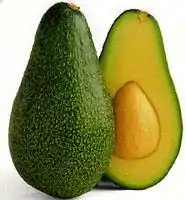
| Avocado | |
|---|---|
| Hex triplet | #568203 |
| HSV (h, s, v) | (81°, 98%, 51%) |
| sRGBB (r, g, b) | (86, 130, 3) |
| Source | Pourpre.com |
| ISCC–NBS descriptor | Deep yellow green |
| B: Normalized to [0–255] (byte) H: Normalized to [0–100] (hundred) | |
Avocado is a dark yellow-green color that is a representation of the color of the outer surface of an avocado.[38] Avocado, along with other earthy tones like harvest gold and burnt orange, was a common color for consumer goods like automobiles, shag carpets, and household appliances during the 1970s.[38]
Kombu green
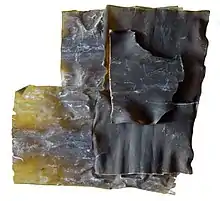
| Kombu green | |
|---|---|
| Hex triplet | #354230 |
| HSV (h, s, v) | (103°, 27%, 26%) |
| sRGBB (r, g, b) | (53, 66, 48) |
| Source | Pantone TPX[39] |
| ISCC–NBS descriptor | Dark olive green |
| B: Normalized to [0–255] (byte) H: Normalized to [0–100] (hundred) | |
The color kombu green is displayed at right.
The color kombu green is a representation of the color of kombu, edible kelp from the family Laminariaceae widely eaten in East Asia.
The source of this color is the "Pantone Textile Paper eXtended (TPX)" color list, color #19-0417 TPX—Kombu Green.[40]
Asparagus
| Asparagus | |
|---|---|
| Hex triplet | #87A96B |
| HSV (h, s, v) | (93°, 37%, 66%) |
| sRGBB (r, g, b) | (135, 169, 107) |
| Source | Crayola |
| ISCC–NBS descriptor | Moderate yellow green |
| B: Normalized to [0–255] (byte) H: Normalized to [0–100] (hundred) | |
Asparagus is a tone of green that is named after the vegetable. Crayola created this color in 1993 as one of the 16 to be named in the Name the Color Contest.

It is also the color of a wild asparagus plant blowing in the wind of the 1949 classic film Sands of Iwo Jima.
Another name for this color is asparagus green. The first recorded use of "asparagus green" as a color name in English was in 1805.[41]
Artichoke
| Artichoke | |
|---|---|
| Hex triplet | #8F9779 |
| HSV (h, s, v) | (76°, 20%, 59%) |
| sRGBB (r, g, b) | (143, 151, 121) |
| Source | ISCC-NBS[42][43] |
| ISCC–NBS descriptor | Moderate yellow green |
| B: Normalized to [0–255] (byte) H: Normalized to [0–100] (hundred) | |
Artichoke is a color that is a representation of the color of a raw fresh uncooked artichoke. Another name for this color is artichoke green.
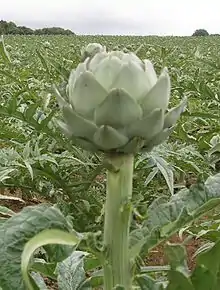
The first recorded use of "artichoke green" as a color name in English was in 1905.[43]
Laurel green
| Laurel green | |
|---|---|
| Hex triplet | #A9BA9D |
| HSV (h, s, v) | (95°, 16%, 73%) |
| sRGBB (r, g, b) | (169, 186, 157) |
| Source | Maerz and Paul[44] |
| ISCC–NBS descriptor | Moderate yellow green |
| B: Normalized to [0–255] (byte) H: Normalized to [0–100] (hundred) | |
Laurel green is a medium light hue of greenish gray similar to asparagus, but lighter.
The first recorded use of laurel green as a name of a color in the English language was in 1705.[45]
Lime
| Lime | |
|---|---|
| Hex triplet | #BFFF00 |
| HSV (h, s, v) | (75°, 100%, 100%) |
| sRGBB (r, g, b) | (192, 255, 0) |
| Source | Maerz and Paul[30][46] |
| ISCC–NBS descriptor | Vivid yellow green |
| B: Normalized to [0–255] (byte) H: Normalized to [0–100] (hundred) | |
Lime is a shade of green, so named because it is a representation of the color of the citrus fruit called limes. It is the color that is in between the web color chartreuse and yellow on the color wheel.[30]
Moss green
| Moss green | |
|---|---|
| Hex triplet | #8A9A5B |
| HSV (h, s, v) | (75°, 41%, 60%) |
| sRGBB (r, g, b) | (138, 154, 91) |
| Source | ISCC-NBS[47][48] |
| ISCC–NBS descriptor | Moderate yellow green |
| B: Normalized to [0–255] (byte) H: Normalized to [0–100] (hundred) | |
Moss green is a tone of green that resembles moss.

The first recorded use of moss green as a color name in English was in 1884.[49]
Dark moss green
| Dark moss green | |
|---|---|
| Hex triplet | #4A5D23 |
| HSV (h, s, v) | (80°, 62%, 36%) |
| sRGBB (r, g, b) | (74, 93, 35) |
| Source | Encycolorpedia[50] |
| ISCC–NBS descriptor | Moderate olive green |
| B: Normalized to [0–255] (byte) H: Normalized to [0–100] (hundred) | |

Reseda green
| Reseda green | |
|---|---|
| Hex triplet | #6C7C59 |
| HSV (h, s, v) | (87°, 28%, 49%) |
| sRGBB (r, g, b) | (108, 124, 89) |
| Source | [Unsourced] |
| ISCC–NBS descriptor | Moderate olive green |
| B: Normalized to [0–255] (byte) H: Normalized to [0–100] (hundred) | |
Reseda green is a shade of greyish green in the classic range of colors of the German RAL colour standard, in which it is named "RAL 6011".[51]
.jpg.webp)
The name derives from the color of the leaves of Reseda odorata, commonly known as mignonette.[52]
Kelly green
| Kelly green | |
|---|---|
| Hex triplet | #4CBB17 |
| HSV (h, s, v) | (101°, 87%, 73%) |
| sRGBB (r, g, b) | (76, 187, 23) |
| Source | [Unsourced] |
| ISCC–NBS descriptor | Vivid yellowish green |
| B: Normalized to [0–255] (byte) H: Normalized to [0–100] (hundred) | |
Kelly green is an American term. The name derives from the fact that the surname Kelly, as well as the color green, are both popular in Ireland. The use of the term as a color name occurred at least as far back as March 1911 when it appeared in The Boston Globe and newspapers across the country as the new color of fashion.[53]
Rifle green
| Rifle green | |
|---|---|
| Hex triplet | #444C38 |
| HSV (h, s, v) | (84°, 26%, 30%) |
| sRGBB (r, g, b) | (68, 76, 56) |
| Source | Pantone TPX[54][55] |
| ISCC–NBS descriptor | Dark grayish olive green |
| B: Normalized to [0–255] (byte) H: Normalized to [0–100] (hundred) | |
The color rifle green is displayed at right.
The source of this color is the Pantone Textile Paper eXtended (TPX) color list, color No. 19-0419 TPX—Rifle green.[56]
The first recorded use of rifle green as a color name in English was in 1858.[57]
Rifle green is so named from the distinctive color of the uniform of rifle regiments (a form of light infantry) of a number of European armies, and is still used as such by rifle regiments in many Commonwealth armies, such as the Rifles and Royal Gurkha Rifles of the British Army and the Queen's Own Rifles of Canada.
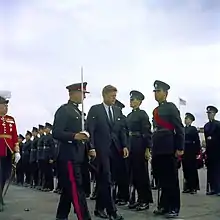
Rifle green was originally adopted by rifle regiments in the 18th century, including the famous 95th Rifles of the Napoleonic Wars. As the traditional role of riflemen was that of marksmen and skirmishers who attacked behind the cover of trees, a dark green uniform was adopted as an early form of camouflage, as opposed to the colorful uniforms worn by other soldiers of the period. The vegetable based dyes used during the 18th and early 19th centuries were not fast, frequently fading after exposure to the elements to lighter shades of green or even brown. While this had advantages in terms of reduced visibility on active service, it did not make for a smart appearance on the peace-time parade ground. Accordingly, the color of the rifleman's uniform was progressively darkened until it approached black. After 1890 the development of chemical dyes permitted the adoption of the stable shade of rifle green now worn. In the U.S. armed forces, the green beret may be worn only by soldiers awarded the Special Forces Tab, signifying they have been qualified as special forces soldiers. The special forces beret is officially designated "beret, man's, wool, rifle green, army shade 297". Previously, rifle green uniforms had been issued to Hiram Berdan's elite 1st and 2nd United States Sharpshooters during the American Civil War.
Rifle green was the official uniform color of the Canadian Forces (CF) after unification; it was thereafter generally referred to as "CF green"; indeed, the service dress uniform of the day was referred to as "CF greens". After the introduction of the distinct environmental uniform (DEU), rifle green remained as the uniform color of the winter land environment DEU; a short-lived tan uniform was worn in summer. After the demise of the tans, the rifle green DEU was worn year-round. Rifle green was also the color of the uniform worn by the Northern Irish Royal Ulster Constabulary (RUC) until 2001 where the RUC was renamed the PSNI and while the uniform color remained the same, terminology changed to "bottle green".[58]
Rifle green is 19–0419 TPX in the Pantone palette, or hex code No. 444C38 in the sRGB color space, as shown above.
See also
- Lime (color)
- List of colors
References
- "Chartreuse". The American Heritage Dictionary of the English Language. Houghton Mifflin/Yahoo! Inc. Archived from the original on 2008-06-08. Retrieved 2010-01-19.
- Larousse, Éditions. "Translation : chartreux, chartreuse – french-english dictionary Larousse". www.larousse.com. Retrieved 2015-07-09.
- "Green Chartreuse and Yellow Chartreuse". Chartreuse Liqueurs. Archived from the original on 2008-04-04. Retrieved 2008-05-05.
- Kleiner, Fred S. (2010). Art Through the Ages, 13th ed., Boston: Wadsworth/Cengage, p. 398.
- "Green LED info wanted – pure green, not yellow-green". Ask MetaFilter. Retrieved 2008-05-05.
- "N.Y. Times Overview of the film Chartroose Caboose". Movies.nytimes.com. Retrieved 2009-04-15.
- SIMON, STEPHANIE (7 July 1995). "The Green Firetruck Heresy : Some studies say red is not a safe color. But chartreuse just doesn't excite the masses. : City Smart / How to thrive in the urban environment of Southern California". Articles.latimes.com. Retrieved 20 November 2017.
- Katley99 (4 July 2009). "East Longmeadow 4th of July Parade 2009". YouTube. Retrieved 20 November 2017.
- "Chelsea Handler to write '50 Shades of Chartreuse'" (Sep 18, 2012) USA Today
- Jordan, Louis. "(You Dyed Your Hair) Chartreuse)." By J. Leslie McFarland and Blly Moore. Let the Good Times Roll: The Anthology 1938–1953. Rec. 1950. MCA, 1999.
- "Lyrics of the Louis Jordan song "(You Died Your Hair) Chartreuse"". Louisjordan.com. Archived from the original on 2015-11-24. Retrieved 20 November 2017.
- "Chartreuse Rewind, by Homestuck". Homestuck.bandcamp.com. Archived from the original on 6 October 2016. Retrieved 20 November 2017.
- "Baratpur—Indian Princely State—the only political entity ever to have a chartreuse colored flag". Fotw.us. Archived from the original on 2009-02-11. Retrieved 2009-04-15.
- "No One Lives Forever Game Guide". Gamespot.com. 1996-08-20. Retrieved 2009-04-15.
- The Oxford English Dictionary (Second ed.). 1989.
- The Domestic Monthly: An Illustrated Magazine of Fashion, Literature, and the Domestic Arts (1885) Vol. 23, pp. 162, 237, 368, Blake and Company, New York
- "New Fashions" (May 1889) The Ladies' Home Journal, Vol. 6, No. 6, p. 14, Philadelphia
- The Millinery Trade Review (Sep 1889) Vol. 14, No. 9, p. 18
- "The Identification of Gems" (1898) The Mineral Industry, Vol. 7, p. 283, McGraw-Hill Book Company, New York and London
- "Latest Spring Millinery" (Apr 22, 1905) Dry Goods Reporter Vol. 35, No. 16 p. 33, Chicago
- "The Coloration of Liqueurs" (1910) Pure Products, Vol. 6, No. 1, p. 278, Scientific Station for Pure Products, New York
- Gladys and Gustav Plochere (Dec 15, 1948) Plochere Color System in Book Form, a Guide to Color and Color Harmony, Los Angeles OCLC 5033214
- Billboard (Mar 24, 1956) p. 85
- Kenneth Low Kelly, Deane Brewster Judd (1976) Color: Universal Language and Dictionary of Names, p. 58, U.S. Department of Commerce, National Bureau of Standards; Catalog record for Color: Universal Language and Dictionary of Names at the United States Library of Congress
- See the 1930s version of "Chartreuse green" in the index and color samples, a color not as green as the web color chartreuse, but greener than chartreuse yellow – actually it is a representation of the actual color of green chartreuse liqueur. The first recorded use of chartreuse green as a color name in English was in 1926 – Maerz and Paul A Dictionary of Color Page 192; Color sample of Chartreuse Green: Page 47 Plate 12 Color Sample L2
- "Fashion Confusion" (June 20, 1988) New York Magazine, Vol. 21, No. 25
- Diner, Web. "restaurant web design, restaurant website design, restaurant graphic design, restaurant marketing". Webdiner.
- "Worldchanging – Evaluation + Tools + Best Practices: Bright Green, Light Green, Dark Green, Gray: The New Environmental Spectrum". worldchanging.com. Archived from the original on 2016-01-12.
- Maerz and Paul A Dictionary of Color New York:1930 McGraw-Hill Page 197; Color Sample of Nyanza: Page 61 Plate 19 Color Sample C4 Note: This color originated as a textile color, as indicated by the small T after the name in the index.
- Maerz and Paul A Dictionary of Color New York: 1930 McGraw-Hill; The index refers to Plate 20 Color Sample J1 as Lime Green; this color is shown on Plate 20 as being halfway between yellow-green (the old name for the color that is now called chartreuse green) and yellow on the color wheel.
- The Daily News (London) 14 July 1890. "lime, n2". Oxford English Dictionary online version. Oxford University Press. September 2011. Retrieved 2011-11-15. (subscription or participating institution membership required)
- The color displayed in the color box above matches the color called spring green in the 1930 book by Maerz and Paul A Dictionary of Color New York:1930 McGraw-Hill; the color spring green is displayed on page 59, Plate 18, Color Sample J7.
- Maerz and Paul A Dictionary of Color New York:1930 McGraw-Hill Page 205; Color Sample of Spring Green: Page 59 Plate 18 Color Sample J7
- Maerz and Paul A Dictionary of Color New York:1930 McGraw-Hill Page 202; Color Sample of Pistachio Green: Page 61 Plate 19 Color Sample C6
- Dumas, Firoozeh (May 4, 2010). "A Guide To The Gritty Side Of The French Language". My Guilty Pleasure. NPR Books. Retrieved 30 June 2012.
- Maerz and Paul A Dictionary of Color New York:1930 McGraw-Hill Page 189; Color Sample of Apple Green: Page 61 Plate 19 Color Sample J6
- St. Clair, Kassia (2016). The Secret Lives of Colour. London: John Murray. pp. 230–231. ISBN 9781473630819. OCLC 936144129.
- Type the words "Kombu Green" into the indicated window on the Pantone Color Finder and the color will appear.
- "- Find a Pantone Color – Quick Online Color Tool". Pantone.com. Retrieved 20 November 2017.
- Maerz and Paul A Dictionary of Color New York:1930 McGraw-Hill Page 189
- "Retsof online version of ISCC-NBS Dictionary of Colo(u)r Names – Aa through Az". 26 December 2012. Archived from the original on 26 December 2012.
- Maerz and Paul A Dictionary of Color New York:1930 McGraw-Hill Page 189; Color Sample of Artichoke Green: Page 63 Plate 20 Color Sample B2
- The color displayed in the color box above matches the color called laurel green in the 1930 book by Maerz and Paul A Dictionary of Color New York:1930 McGraw-Hill; the color laurel green is displayed on page 67, Plate 22, Color Sample L1.
- Maerz and Paul A Dictionary of Color New York:1930 McGraw-Hill Page 197; color sample of Laurel Green: Page 67 Plate 22 Color Sample L1. The color displayed in the color box above as "laurel green" matches the color shown in the color sample in Maerz and Paul
- "Color Conversion Tool set to hex code of color #BFFF00 (Lime)". Web.forret.com. Archived from the original on 1 April 2012. Retrieved 2010-06-08.
- The color displayed in the color box above matches the color called moss green in the 1930 book by Maerz and Paul A Dictionary of Color New York:1930 McGraw-Hill; the color moss green is displayed on page 65, Plate 21, Color Sample L2.
- Maerz and Paul A Dictionary of Color New York:1930 McGraw-Hill Page 199; Color Sample of Moss Green: Page 65 Plate 21 Color Sample L2
- "Dark moss green / #4a5d23 Hex Color Code". Encycolorpedia.
- Overview of all RAL Classic colours. RAL gemeinnützige GmbH. Accessed January 2016.
- Nikolas Davies, Erkki Jokiniemi (2008). Dictionary of Architecture and Building Construction. Amsterdam; Boston; London: Elsevier/Architectural Press. ISBN 9780750685023.
- Boston Globe 1911, – retrieved from Newspapers.com.
- Type the words "Rifle green" into the indicated window on the Pantone Color Finder and the color will appear. http://www.pantone.com/pages/pantone/colorfinder.aspx
- The color displayed in the color box above matches the color called Rifle green in the 1930 book by Maerz and Paul A Dictionary of Color New York:1930 McGraw-Hill; the color Rifle green is displayed on page 87, Plate 32, Color Sample A2.
- "Pantone TPX Pantone Color Finder—Type the words "Rifle green" into the indicated window on the Pantone Color Finder and the color will appear". pantone.com.
- Maerz and Paul A Dictionary of Color New York:1930 McGraw-Hill Page 203; Color Sample of Russian Green: Page 87 Plate 32 Color Sample A2
- "Patten Report". BBC News.
